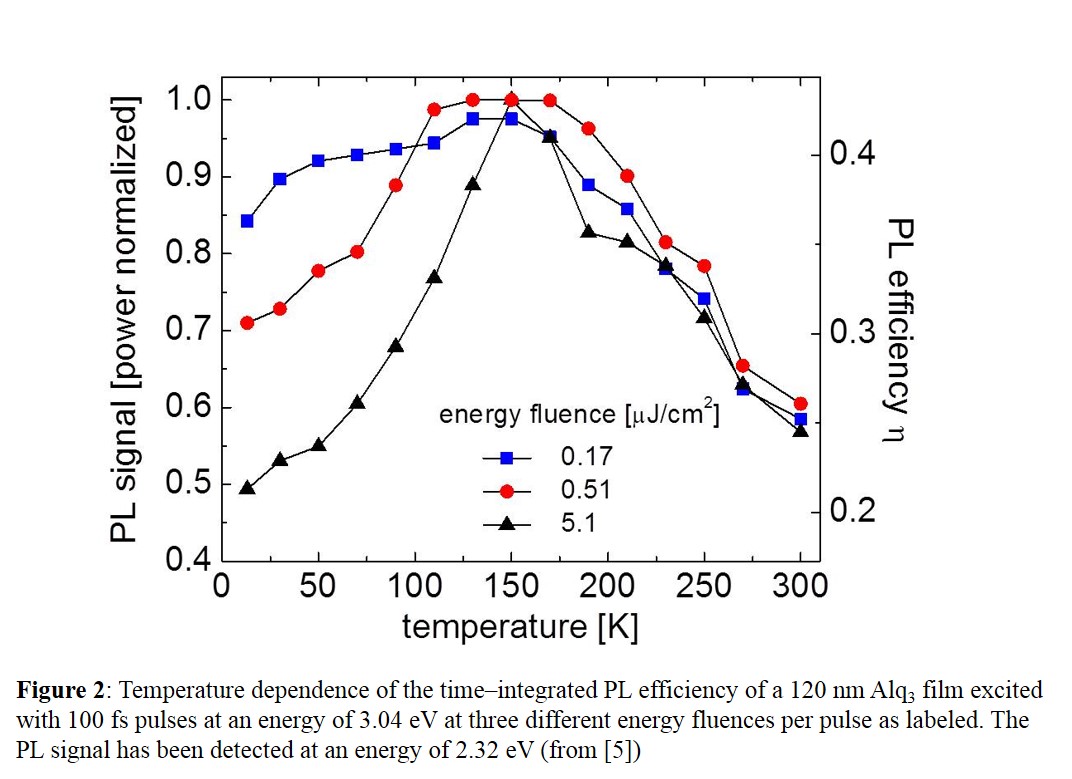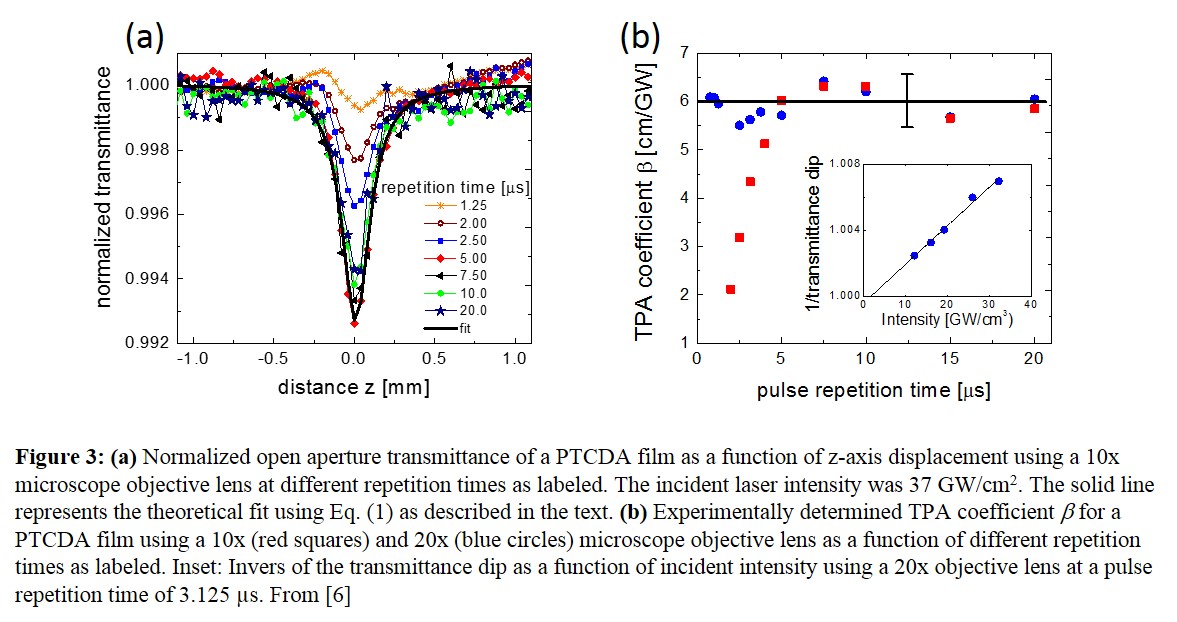Optical Properties of Semiconducting Organic Films
Organic semiconductors are an exciting new class of materials for optics and photonics. When deposited as thin films they show properties which are similar to those of classical semiconductors and made already possible for instance the fabrication of organic light emitting diodes (OLEDs), flat-panel displays and solar cells. Organic semiconductors provide significant advantages compared to classical semiconductors: namely the almost unlimited chemical synthesis and variability of organic molecules, as well as potentially lower fabrication costs of all-optical and optoelectronic devices. It is expected that organic materials will supplement or replace conventional semiconductor devices within the next years.
Excitonic emission in 3,4,9,10-perylentetracarboxylic dianhydride (PTCDA) films
The physical origin of the excitonic emission in polycrystalline molecular films has been the subject of intense research for more than 20 years. In particular the emission from molecular 3,4,9,10-perylentetracarboxylic dianhydride (PTCDA) single crystals and polycrystalline films (see Fig.11) shows a rich variety of excitonic bands at low temperatures (10-100 K) and the identification of these recombination channels is still subject of intense debate. With different experimental techniques like time-resolved photoluminescence (PL)1,2 and PL excitation spectroscopy3 we have been able to isolate and to identify five recombination channels including self-trapped charge transfer (CT) exciton states in which two interacting molecules are involved. Our band assignments are supported by recent PL measurements under uniaxial pressure4

1Reprinted with permission from H. P. Wagner, A. De Silva, T. U. Kampen, Exciton emission in PTCDA Films and PTCDA/Alq3 Multilayers, Phys. Rev. B 70, 235201 (2004), Copyright 2004, The American Physical Society.
2A.Yu Kobitski, R. Scholz, I. Vragovic, H. P. Wagner, D. R. T. Zahn, Low temperature time-resolved photoluminescence characterisation of 3,4,9,10-perylene tetracarboxylic dianhydride crystals, Phys. Rev B 66, 153204 (2002).
3V. R. Gangilenka, L. V. Titova, L. M. Smith, H. P. Wagner, L. A. A. DeSilva, R. Scholz, Selective excitation of exciton transitions in PTCDA crystals and films, Phys. Rev. B 81, 155208 (2010).
4V. R. Gangilenka, A. DeSilva, H. P.Wagner, R. E. Tallman, B. A. Weinstein, R. Scholz, Exciton Emission in PTCDA Thin Films under Uniaxial Pressure, Phys. Rev. B 77, 115206 (2008).
Excitonic emission in Alq3 films
Currently, we are studying thin aluminum quinoline (Alq3) organic films which are frequently used as an efficient emissive layer in organic light emitting devices (OLEDs). To date the external quantum efficiency of Alq3 based OLEDs reaches only ~8%. Researchers all around the world aim to exceed this value by using different OLED architecture as well as modified carrier injection. However, the influence of crystalline order and the interaction between molecules on the photoemission due to intermolecular transitions is still rather unexplored.
The central goal of this research is to investigate the contribution of intermolecular interaction to the light emission as a function of bimolecular energy-transfer and short-range crystalline order in organic films. In particular we want to study and control the exciton annihilation at higher excitation densities as well as the formation of thermally activated charge-transfer (CTEs) between facing ligands of two adjacent Alq3 molecules. Bimolecular quenching and the possibility of CTE transitions are investigated by intensity dependent and temperature dependent PL ranging from 10 to 300 K (see Fig. 25). Time-resolved PL measurements as well as intensity dependent PL investigations under applied uniaxial strain provide additional information about the physical origin of the intermolecular transitions involved.

5Reprinted with permission from A. M. Ajward, X. Wang, N. Wickremasinghe, L. A. A. DeSilva, and H. P. Wagner, Radiative recombination of trapped excitons in Alq3 films: Importance of intermolecular interactions, Phys. Rev. B 88, 045205 (2013), Copyright 2013, The American Physical Society.
Nonlinear optical properties of organic films
The Z-scan technique is a simple and highly sensitive optical technique, which can be used to measure both the nonlinear refractive index and the nonlinear absorption coefficient, simultaneously. Due to this unique feature, Z-scan has been used widely to study the nonlinear optical properties of varieties of materials. In general, Z-scan experiments are performed using femtosecond lasers which usually provide laser pulses at high repetition rates. It has been observed that the nonlinear signal can be substantially modified by cumulative heat effects due to the high repetition rates. We developed a slightly modified “tightly focused Z-scan method” with reduced repetition rate to investigate the nonlinear absorption and nonlinear refractive index of 3,4,9,10-perylentetracarboxylic dianhydride (PTCDA). We could demonstrate that thermal effects can be excluded using this modified Z-scan method (see Figs. 36 and 46). We are currently extending our method to other organic materialsas well as to plasmonic metal/organic films.

6Reprinted with permission from N. Wickremasinghe, X. Wang, H. Schmitzer and H. P. Wagner, Eliminating thermal effects in z-scan measurements of thin PTCDA films, Optics Express 32, 23955 (2014), Copyright 2014, The Optical Society of American.
